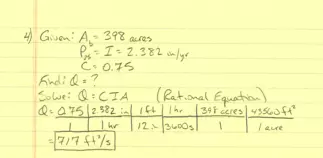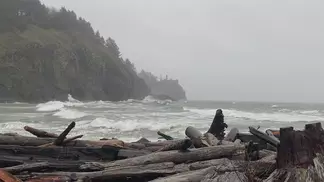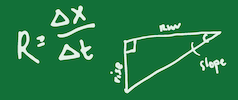How do I solve math word problems?
Breaking down the process to solve math problems in the Earth sciences
"Given/Find/Solve/Evaluate" - A systematic approach to solving word or story problems
Your instructor passes out a paper on the first day of class with a half-page paragraph of words and numbers and asks you to solve the problem. This intimidating activity can be especially daunting for a student in a science class who isn't confident in their math skills, especially applying it in a way they've not done before. Add to that, the instructor may be assuming students are comfortable with word problems, so they don't spend time on the basics. How do you proceed as the instructor watches and waits?
Word problems (from middle or high school you may know them as "story" problems) are an important step in student learning because, in real-world applications, scientists almost never have information ready to just plug into a formula. It's especially helpful to have a dependable way to approach word problems in science, mostly predicated on careful reading and patience! The "Given/Find/Solve/Evaluate" strategy (GFSE for our purposes here) is a simple way to slow yourself down and break a word problem into smaller pieces.
The general premise of GFSE is to figure out all of the different variables and values that are given in the problem (G), find what you're being asked for (F), figure out how to set up and solve the problem (S), and evaluate your answer for correct units and reasonableness of your number (E).
When do I use GFSE?
Any time you are confronted with a math problem, you should have a trusted, consistent approach to finding a solution. Without it, you might feel overwhelmed every time you have to solve one! Given/Find/Solve/Evaluate is one of a number of related methods that involve breaking down a problem. It is a general approach that can be used in any course or scenario where you need to use math principles.

How do I use GFSE?
The main thing to keep in mind when using the GFSE approach is to slow yourself down and work through the problem methodically. That might seem obvious or even annoying, because we often want to jump right in to getting something done. However, if you have struggled with word problems in the past, a likely source of some of those struggles is that you missed key pieces of information or misplaced a variable. These problems are reduced as you work deliberately through the steps below. See the example below for an illustration of how this works and the thought processes that go into the solution.

GFSE for Unit Conversions
Precipitation across the United States varies a great deal because of the large land area and due to topographic and climatic differences across the country. The National Weather Service reports precipitation in inches, but scientists typically use metric. The average annual precipitation for the wettest place in the continental United States is Quillayute, WA, at 99.5 inches, whereas, it is only 2.0 inches in Stovepipe Wells, CA. What is the average annual precipitation in centimeters (cm) and millimeters (mm) at each of these locations?
Step 1. On your paper, start by writing "Given:" After that, list the terms that are given in the problem. For this problem:
Given:
Step 2. Now write "Find" below your "Given" items. Identify the variable that you are being asked to solve for. For this problem...
Find:
Step 3. Write "Solve:" Now you'll begin the solution to the problem. Because you may not be familiar with precipitation, you should consider logic and what you DO already know. Consider this, you're already given precipitation values, so you don't need to calculate anything NEW. All you need to do for this problem is to convert the rainfall amounts to different units!

Step 4. "Evaluate" your answer. If you were asked for specific units, are those the units you finished with? Does your answer make sense?
Helpful Tips
- Work the problem on paper and be as organized as possible. Organized doesn't have to be neat, but neat work tends to be more organized. It's critical that your work can be read, so make it legible.
- Circle, highlight, box out, double-underline, etc. your answers! Make them obvious and easy to find.
- Including the ZERO in front of a decimal value. 0.45 is correct, .45 is incorrect!
- Use correct (or at least reasonable) significant figures! An answer of 12.64578329 cm is technically wrong if you are calculating based on measurements that are not that precise. It's likely 13 cm, 12.6 cm, or 12.65 cm are within the measurement error tolerance. As a general rule, you should use the number of significant figures that the least precise variable the original problem had in it.
- Use scientific notation for large or small values! In most cases, an answer of 12,345, 000 cm should be reported as 1.23 x 107 cm. For more practice with scientific notation, visit the Scientific Notation module.
- Use metric system units unless otherwise specified.
- Spreadsheets and programming can be very powerful tools! As you progress through science, hopefully you will embrace the opportunities to learn the skills to take advantage of them.
GFSE for Equations
Some topics are too large or small, or take very long or very short time intervals, to be especially precise. In these cases, estimates based on idealized conditions can be used, as long as those assumptions are acknowledged. In the case of volcanoes, the size and shape of the feature are prohibitive of an exact volume calculation. Try this example from Mount St. Helens.
On May 18, 1980, Mount St. Helens erupted, initiated by a large landslide on the north slope. The United States Geological Survey had been measuring earthquake activity and using cameras to monitor the potential for an eruption. Following the eruption, the volcano's shape was completely transformed by the landslide and the evacuation of material from the vent. The original shape of the volcano can be approximated to a cone.
The diameter of the volcano at the base of Mount St. Helens is approximately 9.7 km, and the pre-eruptive elevation above the base was 2.9 km. How tall in meters was the volcano before the eruption? Calculate an estimate of the volume of Mount St. Helens before the eruption using its pre-eruption geometry in both cubic feet and cubic miles.
Step 1: Write down the word Given and identify your terms.
Step 2: Write down the word Find and what you are asked for, including units if they are given.
Step 3: Write down the word Solve and start with what you already know.
Step 4: Is your answer reasonable?
Who cares? Calculating the pre-eruptive and post-eruptive volumes of the landscape allows scientists to estimate the actual volume of the eruption. Why might this be important? Consider this...if a similar volcano like Mt. Rainier, near Seattle and Tacoma, WA, were to erupt, the predicted volume of the eruption would be especially important for infrastructure and land development, early warning systems, and evacuation planning.
Where do you solve/use GFSE in Earth science?
- Generally, in science, we solve problems and calculate solutions based on a wide variety of data types and sources. It is rarely possible to just collect a data point, plug it into a pre-defined equation, and spit out a meaningful answer. Here are some examples:
- In Hydrology, we are concerned about the interchange of water between the atmosphere, surface water, groundwater, and the oceans.
- In Volcanology, we calculate hazards based on material viscosity, land slope, eruptive volume, etc.
- In environmental applications, we may have discontinuous data for soil, water, and human impacts that need to be reconciled.
Next steps
Or, if you want even more practice, see More Help below.
More help (resources for students)
- National Council for Special Education: Solving Word Problems in Science and Mathematics
- Khan Academy (https://www.khanacademy.org/) and search "Word Problems"
Pages written by Kyle Fredrick (Pennsylvania Western University - California, PA).


![[creative commons]](/images/creativecommons_16.png)
